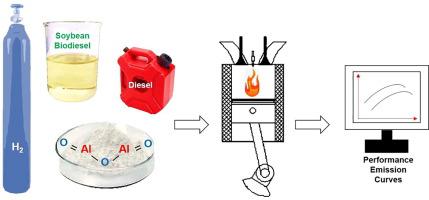Engineering Science and Technology, an International Journal ( IF 5.1 ) Pub Date : 2021-01-24 , DOI: 10.1016/j.jestch.2020.12.022 Erdi Tosun , Mustafa Özcanlı

|
In this study, an experimental work was conducted in a naturally aspirated, 4-stroke, 4 cylinder direct injection compression ignition engine operated with diesel-soybean biodiesel-hydrogen combinations as fuels and aluminum oxide (Al2O3) as nanoparticle additive. Engine tests were carried out between 1200 rpm and 2800 rpm engine speeds by 400 rpm intervals at full load condition. Each tests were repeated three times and results were averaged in order to ensure to gather more accurate results. Power and brake specific fuel consumption (BSFC) as performance and carbon monoxide (CO), carbon dioxide (CO2) and oxides of nitrogen (NOx) as emission characteristics of the engine were determined. Nanoparticle additive was mixed with fuels with the help of an ultrasonic processor. Hydrogen enrichment was achieved through intake manifold. Experiments have exhibited that deteriorations on engine performance with biodiesel utilization can partially or fully be compensated with nanoparticle addition and hydrogen supplementation. CO emission was reduced in all fuels in comparison to diesel fuel. Adverse effects on CO2 emission as a result of biodiesel and nanoparticle additive usage can be eliminated a bit by hydrogen since it has superior combustion characteristics. Unfortunately, all test fuels trigger more NOx release compared with diesel fuel. H-B20-A demonstrated best performance characteristics with 6.64% rise in power and 2.72% reduction in BSFC compared to diesel fuel. Most reduction in CO (15.91%) was achieved with H-B100-A. Least increase in CO2 compared to diesel fuel (6.1%) was realized with H-B20-A while the least CO2 was observed with diesel fuel. In NOx emission, all fuels exhibited more release than diesel fuel. But least rise was observed with B20 as 6.73% in comparison with diesel fuel.
中文翻译:

氢富集对掺有纳米颗粒的柴油-大豆生物柴油共混物运行的柴油发动机性能和排放特性的影响
在这项研究中,在自然吸气,四冲程,四缸直喷压缩点火发动机中进行了实验工作,该发动机以柴油-大豆生物柴油-氢的组合作为燃料,氧化铝(Al 2 O 3)作为纳米颗粒添加剂运行。在满载条件下,以1200 rpm和2800 rpm的发动机转速之间的间隔400 rpm进行了发动机测试。每个测试重复三次,并对结果取平均值,以确保收集更准确的结果。功率和制动单位油耗(BSFC),以性能以及一氧化碳(CO),二氧化碳(CO 2)和氮氧化物(NO x)作为发动机的排放特性。在超声处理器的帮助下,将纳米颗粒添加剂与燃料混合。氢气的富集是通过进气歧管实现的。实验表明,通过使用生物柴油可以使发动机性能下降,而部分或全部可以通过添加纳米颗粒和补充氢来弥补。与柴油相比,所有燃料的一氧化碳排放量均降低。由于生物柴油和纳米粒子添加剂的使用,对CO 2排放的不利影响可以通过氢气消除,因为它具有出色的燃烧特性。不幸的是,所有测试燃料都会触发更多的NO x释放与柴油相比。与柴油相比,H-B20-A表现出最佳的性能特征,功率提高了6.64%,BSFC降低了2.72%。使用H-B100-A可以最大程度地减少CO(15.91%)。与H-B20-A相比,CO 2与柴油相比增加最少(6.1%),而柴油则观察到最少的CO 2。在NO X排放,所有的燃料显示出比柴油更释放。但与柴油相比,B20的增幅最小,为6.73%。











































 京公网安备 11010802027423号
京公网安备 11010802027423号